Advertisement
What Are the Symptoms of Metabolic Syndrome
Updated: Nov 6, 2024
Advertisement
Metabolic syndrome isn’t a single disease. Instead, it’s a group of related conditions that require lab work and medical tests for confirmation. This cluster of metabolic risk factors commonly affects those who are overweight, obese, or have conditions like type 2 diabetes and cardiovascular disease. Sometimes called Syndrome X or dysmetabolic syndrome, it can be tricky to diagnose because of its broad scope. If any of the following symptoms sound familiar, consider seeing a doctor to get checked.
Abdominal Obesity
Abdominal obesity is more than just extra weight—it’s when the body stores fat primarily around the midsection. This waistline measurement is a key marker: for men, it’s 102 cm or more, and for women, it’s 88 cm or more. In Asian American populations, the threshold is lower at 90 cm for men and 80 cm for women. The larger the measurement, the higher the risk of related diseases. If you carry most of your weight in the midsection, it’s worth discussing with your doctor.
Advertisement
Hormone Resistance
When the body becomes resistant to certain hormones, it can’t use them effectively to process sugar, leading to higher blood glucose levels. Left unchecked, this symptom can eventually cause prediabetes or type 2 diabetes. Essentially, excess glucose remains in the bloodstream, which can contribute to more serious health issues if untreated.
Advertisement
Blood Abnormalities
Blood abnormalities aren’t always visible without testing, so it’s important to consult a doctor for lab work if you’re concerned. Elevated C-reactive protein (CRP) levels can indicate inflammation and may prompt further testing for metabolic syndrome. High blood pressure (anything equal to or above 130/85 mmHg) can also be a sign and may need to be managed to protect your heart health.
Advertisement
Coexisting Conditions
Other conditions, like cardiovascular disease, nonalcoholic fatty liver disease, and polycystic ovary syndrome (PCOS), may indicate a higher likelihood of metabolic syndrome. If you already have any of these diagnoses, it’s crucial to keep up with regular checkups. Staying proactive about your health with these conditions can help prevent new complications from arising.
Advertisement
Atherogenic Dyslipidemia
Atherogenic dyslipidemia is when you have high levels of bad cholesterol (LDL) and triglycerides while levels of good cholesterol (HDL) are low. Since these cholesterol levels aren’t visibly obvious, you’ll need a blood test to monitor them. Regularly checking your cholesterol levels can help you catch any imbalances early, reducing the risk of heart disease and other complications.
Advertisement
Fatigue and Tiredness
Feeling tired or fatigued without a clear cause can also be a symptom of metabolic syndrome, particularly if it happens after meals. If you notice a recurring pattern of exhaustion that isn’t due to stress or lack of sleep, consider seeing a specialist to check your metabolic health, hormone levels, and other factors that could impact your energy levels.
Advertisement
Brain Fog and Focus Issues
Aside from physical fatigue, you may also experience “brain fog,” a state where it’s hard to focus even when there are no distractions. Brain fog can feel like zoning out or losing focus during routine tasks. If this mental fog persists, especially without a clear cause like fatigue or stress, it’s worth getting a medical opinion.
Advertisement
Acanthosis Nigricans
Acanthosis Nigricans is a condition that turns the folds of your skin dark brown. It often appears around the neck, armpits, or groin. If you notice this change in skin color that doesn’t wash off, it’s a good idea to consult a doctor. Although rare, Acanthosis Nigricans can be a symptom of metabolic syndrome, and early treatment can help stop it from worsening.
Advertisement
Irregular Sugar and Cholesterol Levels
High levels of triglycerides (above 150 mg/dL) or fasting glucose (over 100 mg/dL) are warning signs for metabolic syndrome. Low HDL cholesterol (under 40 mg/dL for men and 50 mg/dL for women) is also a red flag. Even if these levels aren’t linked to metabolic syndrome, they’re worth addressing with your doctor, as they can indicate other health concerns.
Advertisement
Other Physical Changes
In addition to the symptoms above, you might notice other physical changes that signal metabolic syndrome, such as frequent thirst, excessive urination, persistent fatigue, or blurred vision. When these symptoms appear suddenly and without explanation, it’s best to consult a physician to rule out serious health issues and get appropriate guidance.
Advertisement
Scroll downfor the Next Article
.png)




